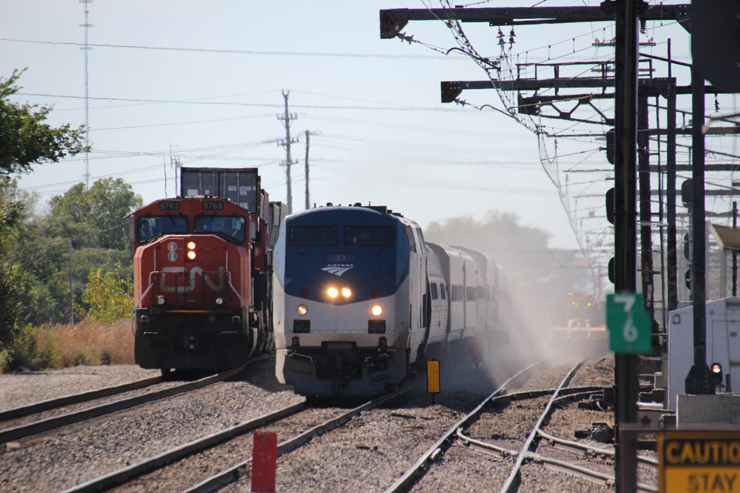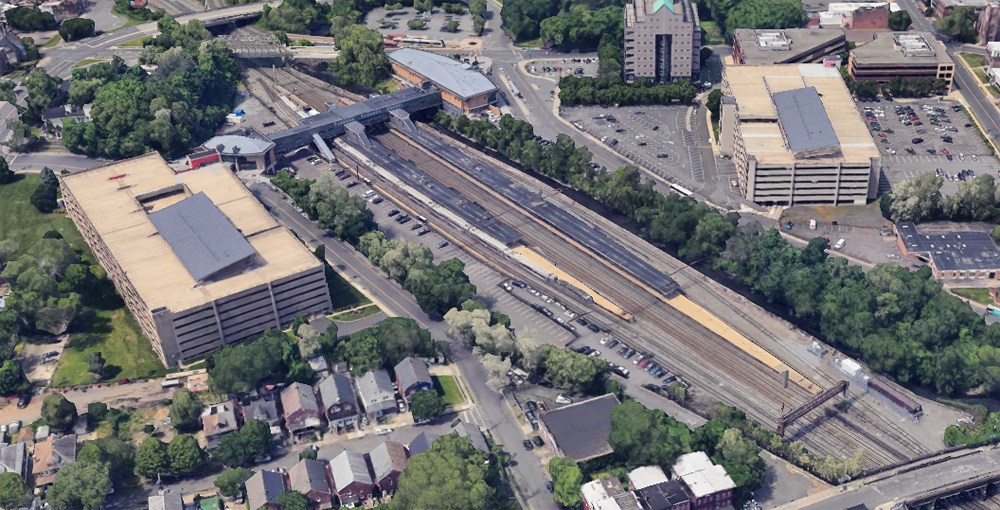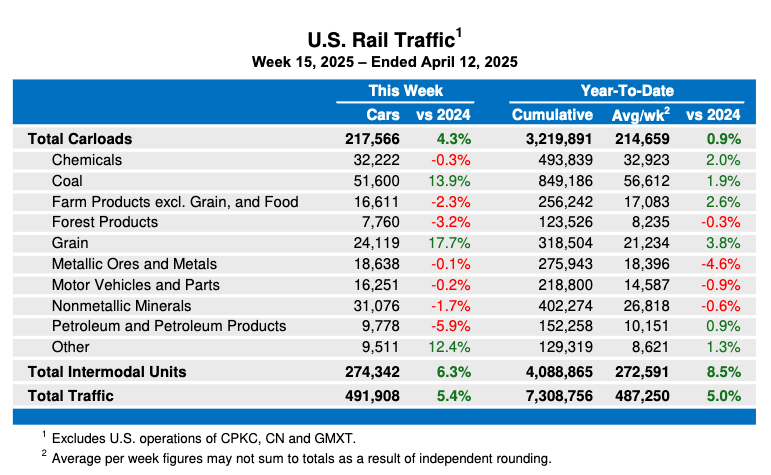The concept of the outfit is a 1980s Canadian Pacific (CP) freight train. Where the Sir-Mix-a-Lot moniker comes in is that power is provided by two first-generation Alco RS-3s (one powered and one not) in the traditional maroon-and-gray paint scheme, a Canadian National (CN) boxcar duded up for Expo 86, a CN boat carrier (with its origins being the no. 6416 boat transport car), a flatcar with a jumbo tree trunk, a coal hopper (again, a postwar-style four-bay model), and a modern CP caboose in multi-mark colors. In short, this is one busy-looking set that has a well-mixed consist!
The head end
I like the concept of two RS-3s. This gives the operator more bang for the (Canadian) buck than, say, an F3A and a cabless F3B. And I’ll toss this out – the powered RS-3 in this set should be a standard for starter sets modeling the 1950s or ’60s.
This model is pretty much the basic RS-3 Lionel offered in the 1990s, of which I have owned three. Externally, both the powered and dummy units look the same, save for road number.
Compared to the Minneapolis & St. Louis starter set RS-3 reviewed in the December 2010 issue of CTT, this is an upgraded locomotive. The powered unit has two can-style motors, a steel frame, and stamped-steel handrails. It has lighting, and both units have crew figures. There also are TrainSounds and a smoke unit.
The shell of the RS-3 has a nice level of cast-in detail. All the major identity reference points are present, including deep impressions for doors, hatches, hinges, and latches.
Topside, there is a nice cast-in screen over the radiator – to the point of even having cast-in bolts like the real locomotive to hold the screen onto the body.
The steel frame, die-cast metal fuel tank and truck side frames, and two large motors add to the model’s heft.
The maroon, yellow, and gray paint scheme is well executed. Application of the complex Canadian Pacific paint scheme on the locomotive shells was excellent, and all the color transitions were clean and sharp.
The rolling stock
The cars for this set are made well and feature die-cast metal trucks and couplers.
The no. 26632 Canadian National boat loader is a bit of a salute to postwar tooling. Heck, it may even be made from the same tooling as the 6416 boat transport car cataloged in 1961-63! An unobtrusive clear-plastic cradle holds the boat hulls in place.
Oddly, the model has both the relatively modern CN “worm” logo and the historic CNR maple leaf logo, but the graphics are well done.
The no. 26631 Canadian Pacific log car is actually an operating dump car similar to the postwar no. 3361. The single log, however, is so enormous that metal chains hold it in place. With the chains removed, the car’s solenoid has enough oomph to roll the plastic log off the car – a terrifying thought for O gauge trackside people!
The no. 26430 Canadian Pacific hopper is based on the no. 6436-style four-bay hopper from postwar days. Occasionally this type of car has a covered hopper-style roof you can install to simulate hauling grain or cement, but this car just came with the coal load.
The no. 25096 Canadian National boxcar is a traditionally sized rig decorated in a reprise of celebratory paint schemes used on the Canadian National to commemorate Expo 86.
The no. 36661 Canadian Pacific CA-4 caboose (a center-cupola model) is really the fish out of water with this set. This is a scale detailed item that stands out amid the traditionally sized and detailed components.
The caboose has thin wire grab irons and finely made brake wheels on each end. There are also safety chains on the handrails as well as add-on grab irons on both sides of each corner.
The roofwalk is a delicate-looking add-on piece with see-through mesh. There are grab irons around the top of the cupola, and two crew figures sit in the crow’s nest.
The caboose is equipped with a smoke unit, and there are on/off switches for the unit and the interior lighting beneath the frame. There are even wire supports for the smokestack. The car is heavy and features die-cast metal high-speed truck sideframes. Add a decorated undercarriage with a battery box and brake-line detailing, and the only thing the car lacks is a decorated interior.
The yellow carbody and the multi-mark logo are well done. I was particularly impressed by the well-executed silver accent paint on the window frames and the car doors.
On the test track
Having a set with a pair of locomotives with cabs is a smart idea. Even though just one is powered, it gives the illusion of having more than a single locomotive. And if you have a two-switch run-by, you can move the duo from the back to the front, and head off in the opposite direction. You can’t do that with an A-B combo!
The locomotive may be conventional-only, but it’s packed with the basic TrueSounds sound system, a smoke unit, two motors, and traction tires. Directional and smoke unit controls are on the underside of the frame.
Because the train is controlled by the throttle power level, the slower the locomotive goes the lower the sound level and smoke unit output. The smoke unit operates well at 14 to 16 volts.
The locomotive motors operated smoothly and quietly. Our low-speed average was 33.2 scale miles per hour, and the high-speed average was 78 scale miles per hour. Drawbar pull was a respectable 1 pound 8 ounces.
I was pleased to find that the cab was illuminated and there was directional lighting – for newbies, this means the headlight illuminates depending on which direction the locomotive is going.
The sound system was satisfactory. It struck me as more of a digital sound of an engine thrum or the clang of a bell than an accurate reproduction of an actual train sound, but it filled the.
When formed as a train, the locomotive and cars ran smoothly.
The set includes a loop of Lionel’s FasTrack, which connects easily and provides first-rate power connectivity.
Power is supplied by a Lionel CW-80 transformer.
Of the three Lionel sets I’ve recently reviewed, this one will probably have the longest life on a model railroad – an interesting train with quality components and a powerful locomotive is a recipe for success.
Features: Two Alco RS-3 locomotives (one powered, one unpowered), four freight cars, and a caboose, loop of Lionel FasTrack; CW-80 transformer. Powered locomotive has two can-style motors, smoke unit, and TrainSounds; caboose has lights and a smoke unit















I bought it for Christmass. I like it. The only thing is about the sound. At a low voltage, the sound is not realistic. But the rest works great. Hopefully, Lionel will bring back his trains production in America…
I agree with Bruce. Williams seems bulletproof. I've been burned with
modern lionel and MTH. All of my 12 locos now are postwar Lionel or
Williams with one exception and I'm working on switching that out.
Railmark
I bought the same set in November. Within two weeks the speaker went out on the locomotive. Had to take it back to get repaired. Then a friend told me about Williams. I'm a lot happier with the Williams. Will have to put a lot of thought into my next Lionel purchase. I was very disappointed with the set considering what Lionel charges for their sets and everything else they make. If Lionel brings production back to America I might consider them in the future. And yes I know Williams is made in China. But they seem to have a better quality!
I enjoyed the review, but have one correction. The review mentions that the operating log car is similar to the postwar 3361 which was first offered in 1955 and was solenoid operated, by the control rails of a remote control track section. The photo however, appears to be a car based on the 3362, which replaced the 3361 in 1961 and was spring loaded. It was released through a center plunger being pulled down by the uncoupling magnet. That version has no solenoid. In operation, the 3361 returned the bin to a flat position after unloading, but with the 3362 you must manually reset the tipping bin.